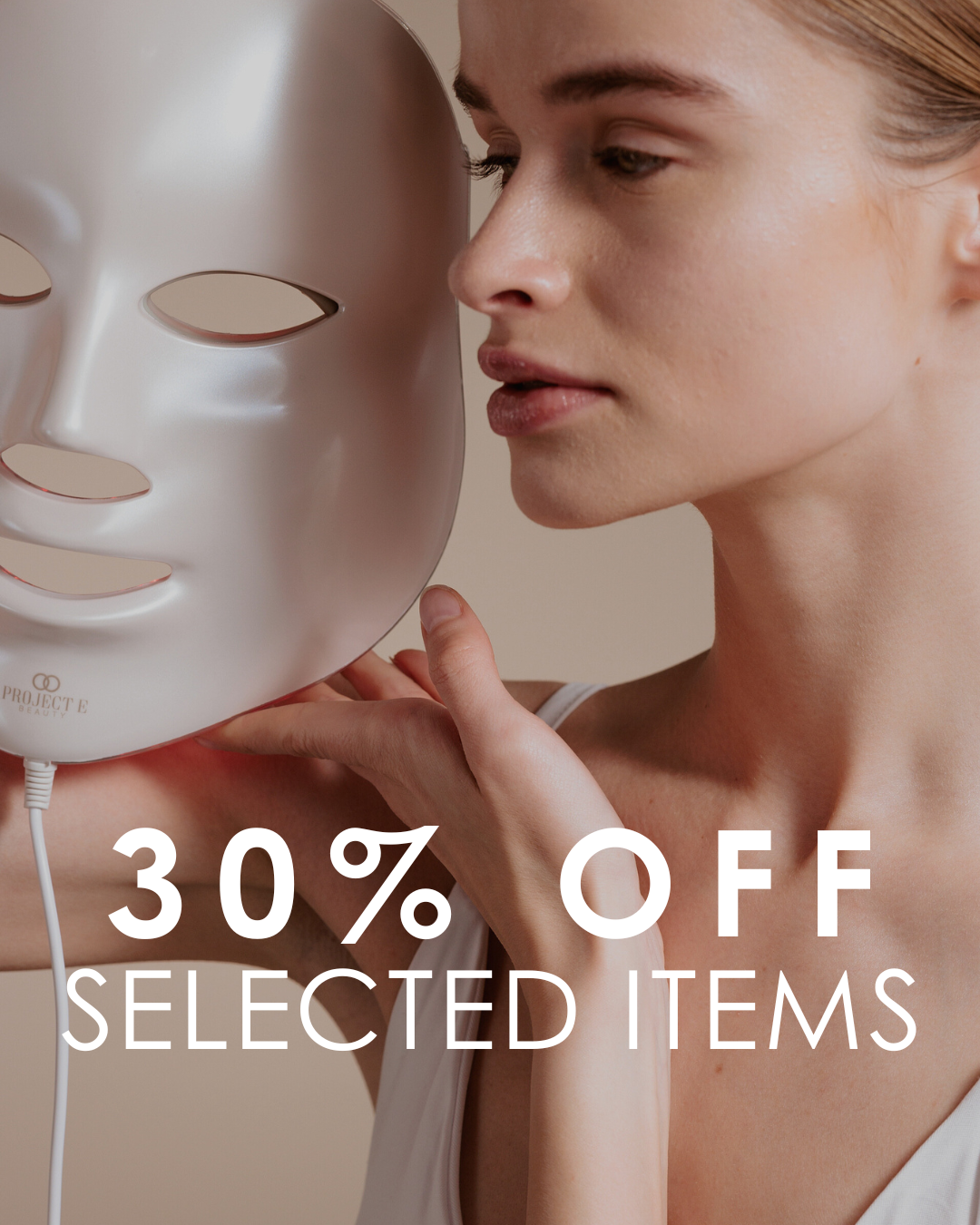
Should I Use Vitamin C or Retinol with LED Light Therapy?
Estimated reading time: 9 minutes
IN THIS ARTICLE:
- 01 What is Vitamin C?
- 02 What are the Benefits of Using Vitamin C in Skincare?
- 03 How Does Vitamin C Work with LED Light Therapy?
- 04 Is LED Light Therapy Safe When Combined with Vitamin C?
- 05 How Does Red LED Light Therapy Work?
- 06 What is Retinol?
- 07 What are the Benefits of Using Retinol?
- 08 How does Retinol Work with LED Light Therapy?
- 09 Is LED Light Therapy Safe When Combined with Retinol?
- 10 Can I Use Vitamin C and Retinol Together?
- 11 What are the Benefits of Using Vitamin C and Retinol with LED Light Therapy?
- 12 How much Vitamin C and Retinol can be used with LED Light Therapy?
- 13 The Takeaway
The skincare doublespeak can seem never ending, and sometimes pretty confusing. But not to worry, we are here to help you decode two of the most trending skincare ingredients of the moment, retinol and vitamin C. Both vitamin C and retinol are potent skincare ingredients that sure deserve a place in any skincare regimen when incorporated correctly with other treatments.
Vitamin C is a powerful antioxidant with the power to brighten the skin and prevent signs of premature aging, while retinol (a vitamin A derivative) is known for its powerful anti-aging benefits. So where do they fit in our routine with LED light therapy?
Below we hope to unpack all there is to know about these powerful skin actives and how you can safely and effectively pair them with your LED light therapy treatment to maximize the benefits of both.
What is Vitamin C?
Vitamin C is a skincare powerhouse. As an antioxidant, vitamin C is renowned for neutralizing free radicals, harmful molecules that can lead to infection and disease. While getting vitamin C from your diet or an oral supplement remains important, applying vitamin C topically in the form of a skincare serum or moisturizer has a powerful impact on the skin.
This skincare superstar is beloved for its ability to brighten the complexion, fade dark spots, boost collagen production, and protect the skin from environmental stressors like pollution and UV damage. By neutralizing free radicals, vitamin C helps combat premature aging, leaving your skin looking radiant and youthful.
What are the Benefits of Using Vitamin C in Skincare?
Here are more reasons to love Vitamin C:
-
Potent antioxidant that helps neutralize free radical to protect the skin from oxidative stress, UV damage and pollution.
-
Brightens the skin by inhibiting melanin production, reducing dark spots, and promoting a more even skin tone.
-
It stimulates collagen synthesis, essential for maintaining skin firmness and elasticity, leading to a more youthful appearance.
-
It has anti-inflammatory properties that can help calm irritated skin, reduce redness, and improve overall skin health.
How Does Vitamin C Work with LED Light Therapy?
Vitamin C complements LED light therapy by providing additional antioxidant protection to the skin, enhancing the therapeutic effects of the treatment. It can also help repair damaged skin cells, promote cell turnover, and rejuvenate the skin.
The combination of vitamin C and LED light therapy can work synergistically to address various skin concerns such as acne, fine lines, and dullness, resulting in clearer, smoother, and more radiant skin.
Is LED Light Therapy Safe When Combined with Vitamin C?
Using vitamin C with LED light therapy is considered safe and effective. Vitamin C can enhance the benefits of LED light therapy by providing additional protection and nourishment to the skin. This combination can result in clearer, smoother, and more radiant skin, making it a popular choice for individuals looking to enhance their skincare routine.
The red light wavelength pairs well with vitamin C to boost collagen production.
How Does Red LED Light Therapy Work?
Key skin reminder: red light stimulates the production of adenosine triphosphate (ATP), which energizes the cells. This increase in energy aids in collagen synthesis, a process that is further supported by the use of vitamin C. Think of vitamin C as a follow up treatment to lock in and bolster all the powerful red LED light therapy benefits.
What is Retinol?
Retinol, a vitamin A derivative, has captured the spotlight in the skincare world for its exceptional anti-aging and skin renewal properties. It’s renowned for its ability to enhance skin texture and combat signs of aging.
Retinol increases cell turnover to foster a more vibrant and youthful complexion. As a type of retinoid, a group of compounds linked to vitamin A, retinol works wonders as an anti-aging agent by stimulating fibroblasts. These cells are pivotal in producing collagen fibers, a key protein for anti-aging naturally found in the body.
What are The Benefits of Using Retinol?
For those looking to combat signs of aging and improve the overall health and appearance of their skin, these benefits make retinol a popular and effective ingredient in skincare products
Key Benefits:
-
Anti-aging properties
-
Skin renewal
-
Collagen stimulation
-
Skin tone improvement
-
Texture refinement
How does Retinol Work with LED Light Therapy?
Red LED light therapy benefits are somewhat similar to the effects of topical retinol. When combined, these treatments help address various skin concerns such as fine lines, acne and hyperpigmentation. Retinol largely works on the surface of the skin (epidermis), while red light therapy technology penetrates deeper into the dermis to stimulate collagen synthesis there. Together they are a very effective skin combination.
Retinol, known for stimulating collagen production and promoting skin cell turnover, can complement the rejuvenating effects of LED light therapy. The skin-renewing properties of retinol can help repair damaged skin cells, improve skin texture, and enhance overall skin health.
The key is to introduce both treatments gradually into your routine and consult with a skincare professional to ensure they are suitable for your skin type and condition. If you are new to retinol, use once per week and build up gradually as tolerance increases.
Is LED Light Therapy Safe When Combined with Retinol?
When using retinol and LED light therapy together, there are a few potential risks to keep in mind. While these risks are generally minimal, it is important to be aware of them:
- Skin sensitivity - both retinol and LED light therapy can cause skin sensitivity. If you are new to either treatment leave a few hours after your LED light therapy to apply retinol
- Increased sun sensitivity - retinol can makes the skin more sensitive to light so never apply retinol before an LED light therapy treatment
- Interaction with other skincare ingredients - retinol can interact with certain skincare ingredients, such as AHAs (alpha hydroxy acids) or BHAs (beta hydroxy acids), which can increase the risk of irritation. It's essential to check for any ingredient interactions and consult with a skincare professional or dermatologist if you're unsure about combining specific products.
Can I Use Vitamin C and Retinol Together?
Yes, you can use Vitamin C and retinol together in your skincare routine, however not at the same time.
Tips for incorporating vitamin C and retinol into your skincare routine:
Layer appropriately
Apply vitamin C in the morning as it provides antioxidant protection throughout the day. Retinol is best used at night since it can increase skin sensitivity to sun exposure. Always use a broad spectrum SPF the morning after applying retinol.
Start with lower concentrations
Begin with lower concentrations of both vitamin C and retinol to allow your skin to adjust and minimize the risk of irritation. Gradually increase the concentration as your skin becomes more tolerant. All topical products should be labeled with the relevant concentration.
Hydrate and protect
Follow up with a serum or thick moisturizer to keep your skin calm and hydrated after use.
While many can use vitamin C and retinol safely, it's wise to do a patch test and seek advice from a skincare professional or dermatologist if you have specific concerns or skin conditions.
What are the Benefits of Combining Vitamin C and Retinol with LED Light Therapy?
- Enhanced anti-aging effects
- Increased collagen production
- Improved skin texture and tone
- Brightening and radiance Protection against environmental damage
How much Vitamin C and Retinol can be used with LED light therapy?
This will vary depending on individual skin sensitivity, tolerance, and specific skincare goals.
For vitamin C, concentrations typically range from 10% to 20%. Beginners may want to start with a lower concentration, around 10%, and assess their skin's reaction before potentially increasing to a higher percentage. Gradually build up tolerance to find the concentration that works best for your skin.
When it comes to retinol, concentrations usually range from 0.025% to 1%. For beginners, it's advisable to start with a lower concentration, such as 0.025% or 0.05%. This allows your skin to adjust to the ingredient and minimizes the risk of irritation.
LumaLux Face+ | Pro LED Light Therapy Face & Neck Mask
Red, infrared, deep infrared for fine lines, acne, and hyperpigmentation, dryness
The Takeaway
Combining vitamin C and retinol with LED light therapy offers a natural and effective approach to skincare. Vitamin C provides antioxidant protection, brightens the skin, and stimulates collagen production, while retinol offers anti-aging benefits and promotes skin renewal. Together with LED light therapy, these ingredients work in harmony to address various skin concerns, such as fine lines, uneven skin tone, and texture.
To find the optimal concentrations of vitamin C and retinol, it's recommended to start with lower concentrations and gradually increase as your skin adjusts. It's always a good idea to consult with a skincare professional to receive personalized advice that suits your specific needs.
Remember to conduct patch tests and protect your skin with sunscreen while using these ingredients. By incorporating vitamin C, retinol, and LED light therapy into your skincare routine consistently, you can achieve healthier, more radiant skin naturally.
Explore our full range of LED light therapy devices here and skincare range here to build a powerful and effective skincare routine backed by science.

written by Charlotte Rycroft














Leave a comment
This site is protected by hCaptcha and the hCaptcha Privacy Policy and Terms of Service apply.